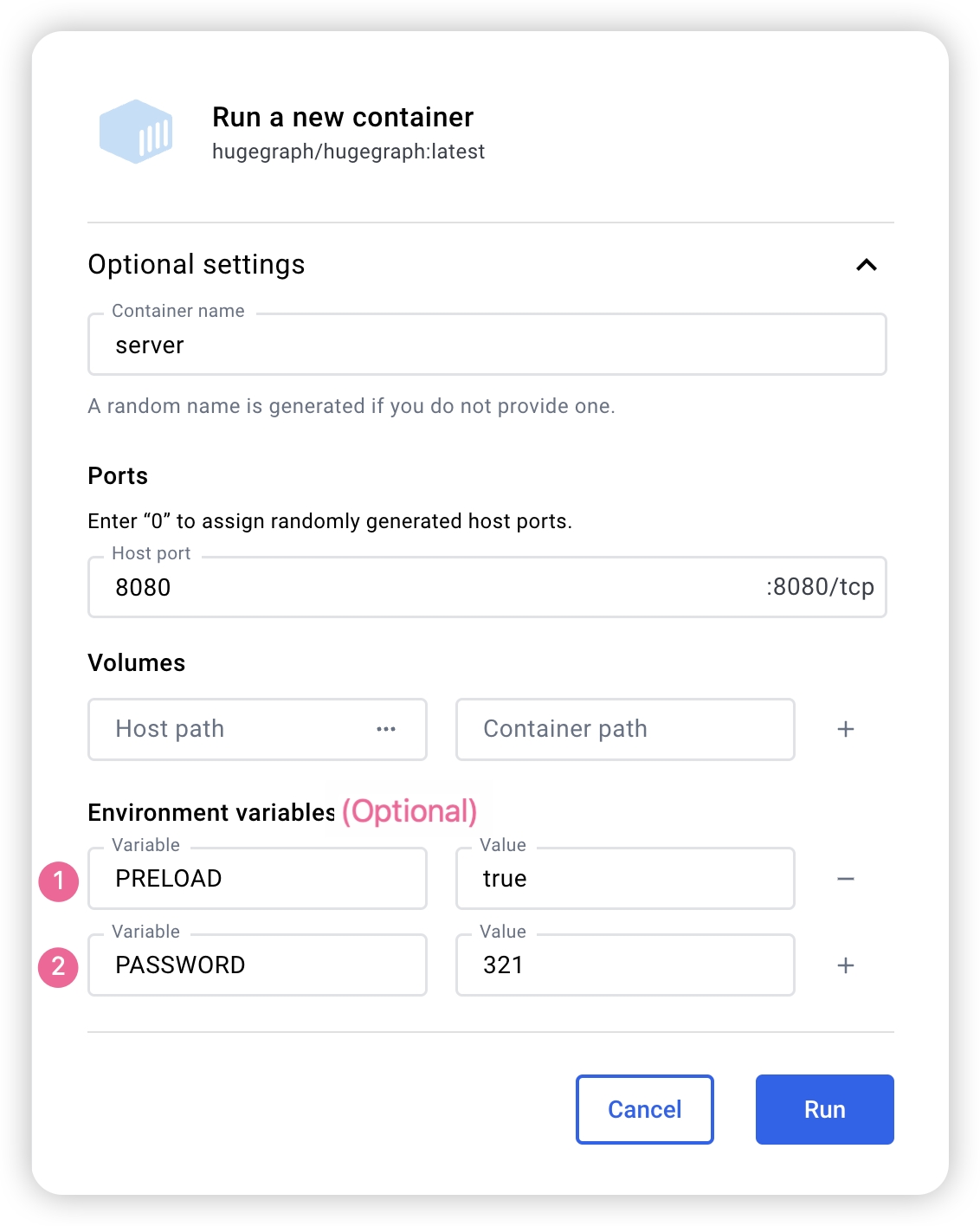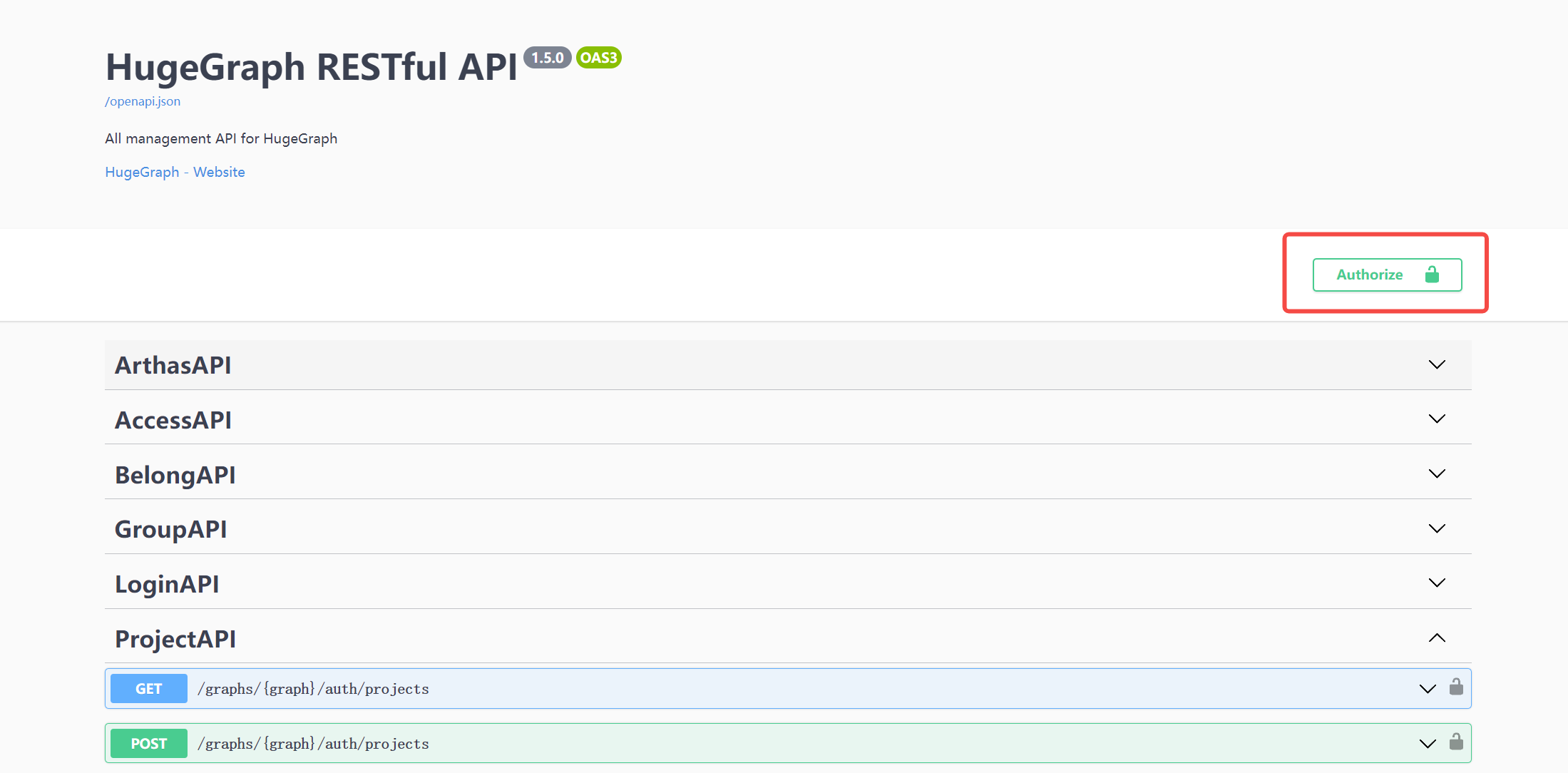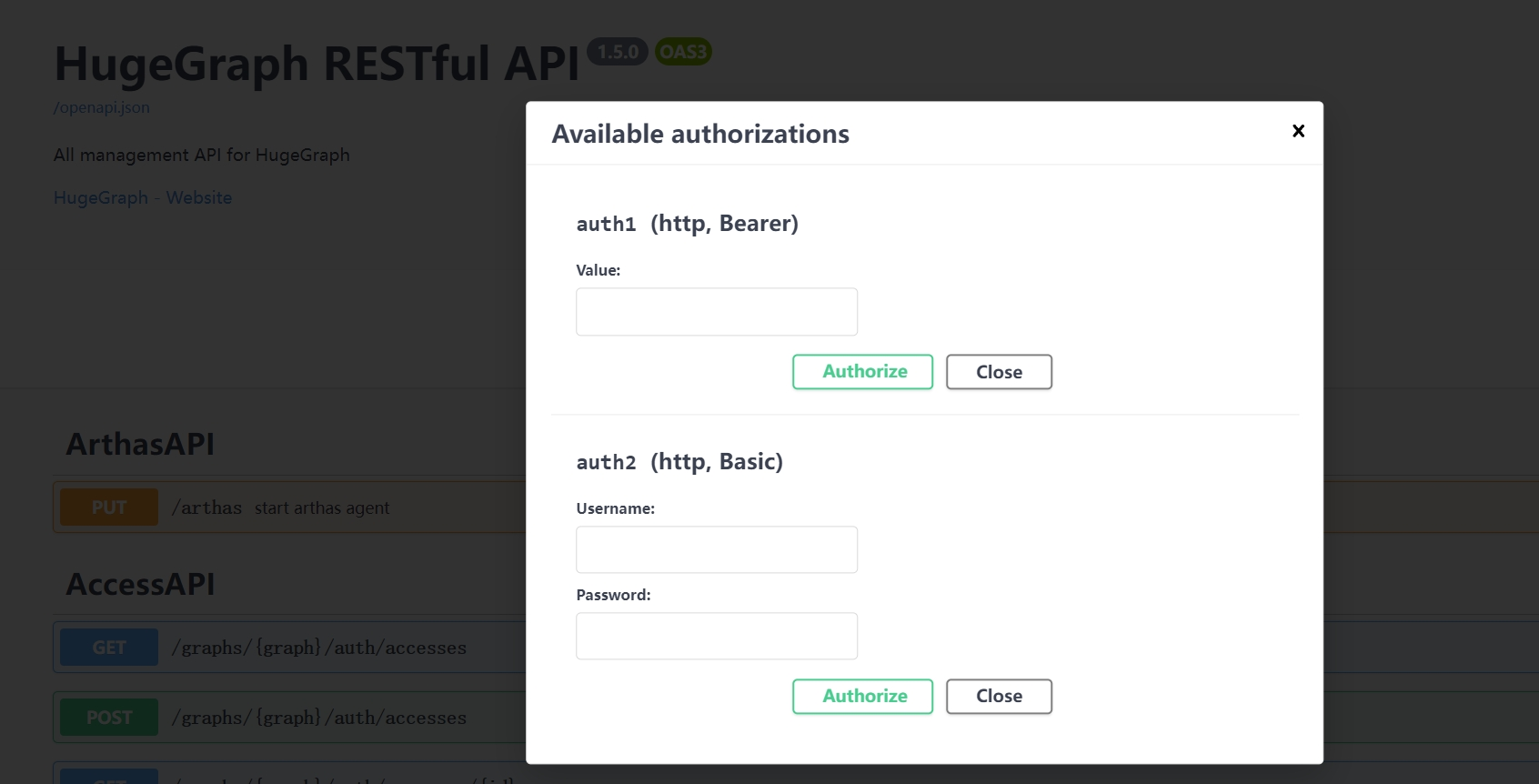HugeGraph-Server Quick Start
1 HugeGraph-Server Overview
HugeGraph-Server is the core part of the HugeGraph Project, contains submodules such as Core, Backend, API.
The Core Module is an implementation of the Tinkerpop interface; The Backend module is used to save the graph data to the data store, currently supported backends include: Memory, Cassandra, ScyllaDB, RocksDB; The API Module provides HTTP Server, which converts Client’s HTTP request into a call to Core Module.
There will be two spellings HugeGraph-Server and HugeGraphServer in the document, and other modules are similar. There is no big difference in the meaning of these two ways, which can be distinguished as follows:
HugeGraph-Serverrepresents the code of server-related components,HugeGraphServerrepresents the service process.
2 Dependency for Building/Running
2.1 Install Java 11 (JDK 11)
Consider using Java 11 to run HugeGraph-Server (compatible with Java 8 before 1.5.0),
and configure by yourself.
Be sure to execute the java -version command to check the jdk version before reading
Note: Using Java8 will lose some security guarantees, we recommend using Java11 in production or
environments exposed to the public network and enable Auth authentication.
3 Deploy
There are four ways to deploy HugeGraph-Server components:
- Method 1: Use Docker container (Convenient for Test/Dev)
- Method 2: Download the binary tarball
- Method 3: Source code compilation
- Method 4: One-click deployment
3.1 Use Docker container (Convenient for Test/Dev)
You can refer to Docker deployment guide.
We can use docker run -itd --name=graph -p 8080:8080 hugegraph/hugegraph to quickly start an inner HugeGraph server with RocksDB in background.
Optional:
- use
docker exec -it graph bashto enter the container to do some operations. - use
docker run -itd --name=graph -p 8080:8080 -e PRELOAD="true" hugegraph/hugegraphto start with a built-in example graph. We can useRESTful APIto verify the result. The detailed step can refer to 5.1.7 - use
-e PASSWORD=123456to enable auth mode and set the passoword for admin. You cna find more details from Config Authentication
If you use docker desktop, you can set the option like:

Also, if we want to manage the other Hugegraph related instances in one file, we can use docker-compose to deploy, with the command docker-compose up -d (you can config only server). Here is an example docker-compose.yml:
version: '3'
services:
server:
image: hugegraph/hugegraph
container_name: server
# environment:
# - PRELOAD=true
# PRELOAD is a option to preload a build-in sample graph when initializing.
# - PASSWORD=123456
# PASSWORD is an option to enable auth mode with the password you set.
ports:
- 8080:8080
Note:
The docker image of hugegraph is a convenience release to start hugegraph quickly, but not official distribution artifacts. You can find more details from ASF Release Distribution Policy.
Recommand to use
release tag(like1.3.0) for the stable version. Uselatesttag to experience the newest functions in development.
3.2 Download the binary tar tarball
You could download the binary tarball from the download page of ASF site like this:
# use the latest version, here is 1.3.0 for example
wget https://downloads.apache.org/incubator/hugegraph/{version}/apache-hugegraph-incubating-{version}.tar.gz
tar zxf *hugegraph*.tar.gz
# (Optional) verify the integrity with SHA512 (recommended)
shasum -a 512 apache-hugegraph-incubating-{version}.tar.gz
curl https://downloads.apache.org/incubator/hugegraph/{version}/apache-hugegraph-incubating-{version}.tar.gz.sha512
3.3 Source code compilation
Please ensure that the wget command is installed before compiling the source code
We could get HugeGraph source code by 2 ways: (So as the other HugeGraph repos/modules)
- download the stable/release version from the ASF site
- clone the unstable/latest version by GitBox(ASF) or GitHub
# Way 1. download release package from the ASF site
wget https://downloads.apache.org/incubator/hugegraph/{version}/apache-hugegraph-incubating-src-{version}.tar.gz
tar zxf *hugegraph*.tar.gz
# (Optional) verify the integrity with SHA512 (recommended)
shasum -a 512 apache-hugegraph-incubating-src-{version}.tar.gz
curl https://downloads.apache.org/incubator/hugegraph/{version}/apache-hugegraph-incubating-{version}-src.tar.gz.sha512
# Way2 : clone the latest code by git way (e.g GitHub)
git clone https://github.com/apache/hugegraph.git
Compile and generate tarball
cd *hugegraph
# (Optional) use "-P stage" param if you build failed with the latest code(during pre-release period)
mvn package -DskipTests -ntp
The execution log is as follows:
......
[INFO] Reactor Summary for hugegraph 1.3.0:
[INFO]
[INFO] hugegraph .......................................... SUCCESS [ 2.405 s]
[INFO] hugegraph-core ..................................... SUCCESS [ 13.405 s]
[INFO] hugegraph-api ...................................... SUCCESS [ 25.943 s]
[INFO] hugegraph-cassandra ................................ SUCCESS [ 54.270 s]
[INFO] hugegraph-scylladb ................................. SUCCESS [ 1.032 s]
[INFO] hugegraph-rocksdb .................................. SUCCESS [ 34.752 s]
[INFO] hugegraph-mysql .................................... SUCCESS [ 1.778 s]
[INFO] hugegraph-palo ..................................... SUCCESS [ 1.070 s]
[INFO] hugegraph-hbase .................................... SUCCESS [ 32.124 s]
[INFO] hugegraph-postgresql ............................... SUCCESS [ 1.823 s]
[INFO] hugegraph-dist ..................................... SUCCESS [ 17.426 s]
[INFO] hugegraph-example .................................. SUCCESS [ 1.941 s]
[INFO] hugegraph-test ..................................... SUCCESS [01:01 min]
[INFO] ------------------------------------------------------------------------
[INFO] BUILD SUCCESS
[INFO] ------------------------------------------------------------------------
......
After successful execution, *hugegraph-*.tar.gz files will be generated in the hugegraph directory, which is the tarball generated by compilation.
3.4 One-click deployment
HugeGraph-Tools provides a command-line tool for one-click deployment, users can use this tool to quickly download, decompress, configure and start HugeGraphServer and HugeGraph-Hubble with one click.
Of course, you should download the tarball of HugeGraph-Toolchain first.
# download toolchain binary package, it includes loader + tool + hubble
# please check the latest version (e.g. here is 1.3.0)
wget https://downloads.apache.org/incubator/hugegraph/1.3.0/apache-hugegraph-toolchain-incubating-1.3.0.tar.gz
tar zxf *hugegraph-*.tar.gz
# enter the tool's package
cd *hugegraph*/*tool*
note:
${version}is the version, The latest version can refer to Download Page, or click the link to download directly from the Download page
The general entry script for HugeGraph-Tools is bin/hugegraph, Users can use the help command to view its usage, here only the commands for one-click deployment are introduced.
bin/hugegraph deploy -v {hugegraph-version} -p {install-path} [-u {download-path-prefix}]
{hugegraph-version} indicates the version of HugeGraphServer and HugeGraphStudio to be deployed, users can view the conf/version-mapping.yaml file for version information, {install-path} specify the installation directory of HugeGraphServer and HugeGraphStudio, {download-path-prefix} optional, specify the download address of HugeGraphServer and HugeGraphStudio tarball, use default download URL if not provided, for example, to start HugeGraph-Server and HugeGraphStudio version 0.6, write the above command as bin/hugegraph deploy -v 0.6 -p services.
4 Config
If you need to quickly start HugeGraph just for testing, then you only need to modify a few configuration items (see next section). for detailed configuration introduction, please refer to configuration document and introduction to configuration items
5 Startup
5.1 Use a startup script to startup
The startup is divided into “first startup” and “non-first startup.” This distinction is because the back-end database needs to be initialized before the first startup, and then the service is started. after the service is stopped artificially, or when the service needs to be started again for other reasons, because the backend database is persistent, you can start the service directly.
When HugeGraphServer starts, it will connect to the backend storage and try to check the version number of the backend storage. If the backend is not initialized or the backend has been initialized but the version does not match (old version data), HugeGraphServer will fail to start and give an error message.
If you need to access HugeGraphServer externally, please modify the restserver.url configuration item of rest-server.properties
(default is http://127.0.0.1:8080), change to machine name or IP address.
Since the configuration (hugegraph.properties) and startup steps required by various backends are slightly different, the following will introduce the configuration and startup of each backend one by one.
If you want to use HugeGraph authentication mode, you should follow the Server Authentication Configuration before you start Server later.
5.1.1 Memory
Click to expand/collapse Memory configuration and startup methods
Update hugegraph.properties
backend=memory
serializer=text
The data of the Memory backend is stored in memory and cannot be persisted. It does not need to initialize the backend. This is the only backend that does not require initialization.
Start server
bin/start-hugegraph.sh
Starting HugeGraphServer...
Connecting to HugeGraphServer (http://127.0.0.1:8080/graphs)....OK
The prompted url is the same as the restserver.url configured in rest-server.properties
5.1.2 RocksDB
Click to expand/collapse RocksDB configuration and startup methods
RocksDB is an embedded database that does not require manual installation and deployment. GCC version >= 4.3.0 (GLIBCXX_3.4.10) is required. If not, GCC needs to be upgraded in advance
Update hugegraph.properties
backend=rocksdb
serializer=binary
rocksdb.data_path=.
rocksdb.wal_path=.
Initialize the database (required on first startup or a new configuration was manually added under ‘conf/graphs/’)
cd *hugegraph-${version}
bin/init-store.sh
Start server
bin/start-hugegraph.sh
Starting HugeGraphServer...
Connecting to HugeGraphServer (http://127.0.0.1:8080/graphs)....OK
5.1.3 Cassandra
Click to expand/collapse Cassandra configuration and startup methods
users need to install Cassandra by themselves, requiring version 3.0 or above, download link
Update hugegraph.properties
backend=cassandra
serializer=cassandra
# cassandra backend config
cassandra.host=localhost
cassandra.port=9042
cassandra.username=
cassandra.password=
#cassandra.connect_timeout=5
#cassandra.read_timeout=20
#cassandra.keyspace.strategy=SimpleStrategy
#cassandra.keyspace.replication=3
Initialize the database (required on first startup or a new configuration was manually added under ‘conf/graphs/’)
cd *hugegraph-${version}
bin/init-store.sh
Initing HugeGraph Store...
2017-12-01 11:26:51 1424 [main] [INFO ] org.apache.hugegraph.HugeGraph [] - Opening backend store: 'cassandra'
2017-12-01 11:26:52 2389 [main] [INFO ] org.apache.hugegraph.backend.store.cassandra.CassandraStore [] - Failed to connect keyspace: hugegraph, try init keyspace later
2017-12-01 11:26:52 2472 [main] [INFO ] org.apache.hugegraph.backend.store.cassandra.CassandraStore [] - Failed to connect keyspace: hugegraph, try init keyspace later
2017-12-01 11:26:52 2557 [main] [INFO ] org.apache.hugegraph.backend.store.cassandra.CassandraStore [] - Failed to connect keyspace: hugegraph, try init keyspace later
2017-12-01 11:26:53 2797 [main] [INFO ] org.apache.hugegraph.backend.store.cassandra.CassandraStore [] - Store initialized: huge_graph
2017-12-01 11:26:53 2945 [main] [INFO ] org.apache.hugegraph.backend.store.cassandra.CassandraStore [] - Store initialized: huge_schema
2017-12-01 11:26:53 3044 [main] [INFO ] org.apache.hugegraph.backend.store.cassandra.CassandraStore [] - Store initialized: huge_index
2017-12-01 11:26:53 3046 [pool-3-thread-1] [INFO ] org.apache.hugegraph.backend.Transaction [] - Clear cache on event 'store.init'
2017-12-01 11:26:59 9720 [main] [INFO ] org.apache.hugegraph.HugeGraph [] - Opening backend store: 'cassandra'
2017-12-01 11:27:00 9805 [main] [INFO ] org.apache.hugegraph.backend.store.cassandra.CassandraStore [] - Failed to connect keyspace: hugegraph1, try init keyspace later
2017-12-01 11:27:00 9886 [main] [INFO ] org.apache.hugegraph.backend.store.cassandra.CassandraStore [] - Failed to connect keyspace: hugegraph1, try init keyspace later
2017-12-01 11:27:00 9955 [main] [INFO ] org.apache.hugegraph.backend.store.cassandra.CassandraStore [] - Failed to connect keyspace: hugegraph1, try init keyspace later
2017-12-01 11:27:00 10175 [main] [INFO ] org.apache.hugegraph.backend.store.cassandra.CassandraStore [] - Store initialized: huge_graph
2017-12-01 11:27:00 10321 [main] [INFO ] org.apache.hugegraph.backend.store.cassandra.CassandraStore [] - Store initialized: huge_schema
2017-12-01 11:27:00 10413 [main] [INFO ] org.apache.hugegraph.backend.store.cassandra.CassandraStore [] - Store initialized: huge_index
2017-12-01 11:27:00 10413 [pool-3-thread-1] [INFO ] org.apache.hugegraph.backend.Transaction [] - Clear cache on event 'store.init'
Start server
bin/start-hugegraph.sh
Starting HugeGraphServer...
Connecting to HugeGraphServer (http://127.0.0.1:8080/graphs)....OK
5.1.4 ScyllaDB
Click to expand/collapse ScyllaDB configuration and startup methods
users need to install ScyllaDB by themselves, version 2.1 or above is recommended, download link
Update hugegraph.properties
backend=scylladb
serializer=scylladb
# cassandra backend config
cassandra.host=localhost
cassandra.port=9042
cassandra.username=
cassandra.password=
#cassandra.connect_timeout=5
#cassandra.read_timeout=20
#cassandra.keyspace.strategy=SimpleStrategy
#cassandra.keyspace.replication=3
Since the scylladb database itself is an “optimized version” based on cassandra, if the user does not have scylladb installed, they can also use cassandra as the backend storage directly. They only need to change the backend and serializer to scylladb, and the host and post point to the seeds and port of the cassandra cluster. Yes, but it is not recommended to do so, it will not take advantage of scylladb itself.
Initialize the database (required on first startup or a new configuration was manually added under ‘conf/graphs/’)
cd *hugegraph-${version}
bin/init-store.sh
Start server
bin/start-hugegraph.sh
Starting HugeGraphServer...
Connecting to HugeGraphServer (http://127.0.0.1:8080/graphs)....OK
5.1.5 HBase
Click to expand/collapse HBase configuration and startup methods
users need to install HBase by themselves, requiring version 2.0 or above,download link
Update hugegraph.properties
backend=hbase
serializer=hbase
# hbase backend config
hbase.hosts=localhost
hbase.port=2181
# Note: recommend to modify the HBase partition number by the actual/env data amount & RS amount before init store
# it may influence the loading speed a lot
#hbase.enable_partition=true
#hbase.vertex_partitions=10
#hbase.edge_partitions=30
Initialize the database (required on first startup or a new configuration was manually added under ‘conf/graphs/’)
cd *hugegraph-${version}
bin/init-store.sh
Start server
bin/start-hugegraph.sh
Starting HugeGraphServer...
Connecting to HugeGraphServer (http://127.0.0.1:8080/graphs)....OK
for more other backend configurations, please refer tointroduction to configuration options
5.1.6 MySQL
Click to expand/collapse MySQL configuration and startup methods
Due to MySQL is under GPL license, which is not compatible with Apache License indeed, Users need to install MySQL, Download Link
Download MySQL’s [driver package] (https://repo1.maven.org/maven2/mysql/mysql-connector-java/), such as mysql-connector-java-8.0.30.jar, and put it into HugeGraph- Server’s lib directory.
Modify hugegraph.properties, configure the database URL, username and password, store is the database name, if not, it will be created automatically.
backend=mysql
serializer=mysql
store=hugegraph
# mysql backend config
jdbc.driver=com.mysql.cj.jdbc.Driver
jdbc.url=jdbc:mysql://127.0.0.1:3306
jdbc.username=
jdbc.password=
jdbc.reconnect_max_times=3
jdbc.reconnect_interval=3
jdbc.ssl_mode=false
Initialize the database (required on first startup or a new configuration was manually added under ‘conf/graphs/’)
cd *hugegraph-${version}
bin/init-store.sh
Start server
bin/start-hugegraph.sh
Starting HugeGraphServer...
Connecting to HugeGraphServer (http://127.0.0.1:8080/graphs)....OK
5.1.7 Create an example graph when startup
Carry the -p true arguments when starting the script, which indicates preload, to create a sample graph.
bin/start-hugegraph.sh -p true
Starting HugeGraphServer in daemon mode...
Connecting to HugeGraphServer (http://127.0.0.1:8080/graphs)......OK
And use the RESTful API to request HugeGraphServer and get the following result:
> curl "http://localhost:8080/graphs/hugegraph/graph/vertices" | gunzip
{"vertices":[{"id":"2:lop","label":"software","type":"vertex","properties":{"name":"lop","lang":"java","price":328}},{"id":"1:josh","label":"person","type":"vertex","properties":{"name":"josh","age":32,"city":"Beijing"}},{"id":"1:marko","label":"person","type":"vertex","properties":{"name":"marko","age":29,"city":"Beijing"}},{"id":"1:peter","label":"person","type":"vertex","properties":{"name":"peter","age":35,"city":"Shanghai"}},{"id":"1:vadas","label":"person","type":"vertex","properties":{"name":"vadas","age":27,"city":"Hongkong"}},{"id":"2:ripple","label":"software","type":"vertex","properties":{"name":"ripple","lang":"java","price":199}}]}
This indicates the successful creation of the sample graph.
5.2 Use Docker to startup
In 3.3 Use Docker container, we have introduced how to use docker to deploy hugegraph-server. server can also preload an example graph by setting the parameter.
5.2.1 Uses Cassandra as storage
Click to expand/collapse Cassandra configuration and startup methods
When using Docker, we can use Cassandra as the backend storage. We highly recommend using docker-compose directly to manage both the server and Cassandra.
The sample docker-compose.yml can be obtained on GitHub, and you can start it with docker-compose up -d. (If using Cassandra 4.0 as the backend storage, it takes approximately two minutes to initialize. Please be patient.)
version: "3"
services:
graph:
image: hugegraph/hugegraph
container_name: cas-server
ports:
- 8080:8080
environment:
hugegraph.backend: cassandra
hugegraph.serializer: cassandra
hugegraph.cassandra.host: cas-cassandra
hugegraph.cassandra.port: 9042
networks:
- ca-network
depends_on:
- cassandra
healthcheck:
test: ["CMD", "bin/gremlin-console.sh", "--" ,"-e", "scripts/remote-connect.groovy"]
interval: 10s
timeout: 30s
retries: 3
cassandra:
image: cassandra:4
container_name: cas-cassandra
ports:
- 7000:7000
- 9042:9042
security_opt:
- seccomp:unconfined
networks:
- ca-network
healthcheck:
test: ["CMD", "cqlsh", "--execute", "describe keyspaces;"]
interval: 10s
timeout: 30s
retries: 5
networks:
ca-network:
volumes:
hugegraph-data:
In this yaml file, configuration parameters related to Cassandra need to be passed as environment variables in the format of hugegraph.<parameter_name>.
Specifically, in the configuration file hugegraph.properties , there are settings like backend=xxx and cassandra.host=xxx. To configure these settings during the process of passing environment variables, we need to prepend hugegraph. to these configurations, like hugegraph.backend and hugegraph.cassandra.host.
The rest of the configurations can be referenced under 4 config
5.2.2 Create example graph when starting server
Set the environment variable PRELOAD=true when starting Docker in order to load data during the execution of the startup script.
Use
docker runUse
docker run -itd --name=server -p 8080:8080 -e PRELOAD=true hugegraph/hugegraph:latestUse
docker-composeCreate
docker-compose.ymlas following. We should set the environment variablePRELOAD=true.example.groovyis a predefined script to preload the sample data. If needed, we can mount a newexample.groovyto change the preload data.version: '3' services: server: image: hugegraph/hugegraph:latest container_name: server environment: - PRELOAD=true ports: - 8080:8080Use
docker-compose up -dto start the container
And use the RESTful API to request HugeGraphServer and get the following result:
> curl "http://localhost:8080/graphs/hugegraph/graph/vertices" | gunzip
{"vertices":[{"id":"2:lop","label":"software","type":"vertex","properties":{"name":"lop","lang":"java","price":328}},{"id":"1:josh","label":"person","type":"vertex","properties":{"name":"josh","age":32,"city":"Beijing"}},{"id":"1:marko","label":"person","type":"vertex","properties":{"name":"marko","age":29,"city":"Beijing"}},{"id":"1:peter","label":"person","type":"vertex","properties":{"name":"peter","age":35,"city":"Shanghai"}},{"id":"1:vadas","label":"person","type":"vertex","properties":{"name":"vadas","age":27,"city":"Hongkong"}},{"id":"2:ripple","label":"software","type":"vertex","properties":{"name":"ripple","lang":"java","price":199}}]}
This indicates the successful creation of the sample graph.
6. Access server
6.1 Service startup status check
Use jps to see a service process
jps
6475 HugeGraphServer
curl request RESTfulAPI
echo `curl -o /dev/null -s -w %{http_code} "http://localhost:8080/graphs/hugegraph/graph/vertices"`
Return 200, which means the server starts normally.
6.2 Request Server
The RESTful API of HugeGraphServer includes various types of resources, typically including graph, schema, gremlin, traverser and task.
graphcontainsvertices、edgesschemacontainsvertexlabels、propertykeys、edgelabels、indexlabelsgremlincontains variousGremlinstatements, such asg.v(), which can be executed synchronously or asynchronouslytraversercontains various advanced queries including shortest paths, intersections, N-step reachable neighbors, etc.taskcontains query and delete with asynchronous tasks
6.2.1 Get vertices and its related properties in hugegraph
curl http://localhost:8080/graphs/hugegraph/graph/vertices
explanation
Since there are many vertices and edges in the graph, for list-type requests, such as getting all vertices, getting all edges, etc., the server will compress the data and return it, so when use curl, you get a bunch of garbled characters, you can redirect to gunzip for decompression. It is recommended to use Chrome browser + Restlet plugin to send HTTP requests for testing.
curl "http://localhost:8080/graphs/hugegraph/graph/vertices" | gunzipThe current default configuration of HugeGraphServer can only be accessed locally, and the configuration can be modified so that it can be accessed on other machines.
vim conf/rest-server.properties restserver.url=http://0.0.0.0:8080
response body:
{
"vertices": [
{
"id": "2lop",
"label": "software",
"type": "vertex",
"properties": {
"price": [
{
"id": "price",
"value": 328
}
],
"name": [
{
"id": "name",
"value": "lop"
}
],
"lang": [
{
"id": "lang",
"value": "java"
}
]
}
},
{
"id": "1josh",
"label": "person",
"type": "vertex",
"properties": {
"name": [
{
"id": "name",
"value": "josh"
}
],
"age": [
{
"id": "age",
"value": 32
}
]
}
},
...
]
}
For detailed API, please refer to RESTful-API
You can also visit localhost:8080/swagger-ui/index.html to check the API.

When using Swagger UI to debug the API provided by HugeGraph, if HugeGraph Server turns on authentication mode, you can enter authentication information on the Swagger page.

Currently, HugeGraph supports setting authentication information in two forms: Basic and Bearer.

7 Stop Server
$cd *hugegraph-${version}
$bin/stop-hugegraph.sh
8 Debug Server with IntelliJ IDEA
Please refer to Setup Server in IDEA